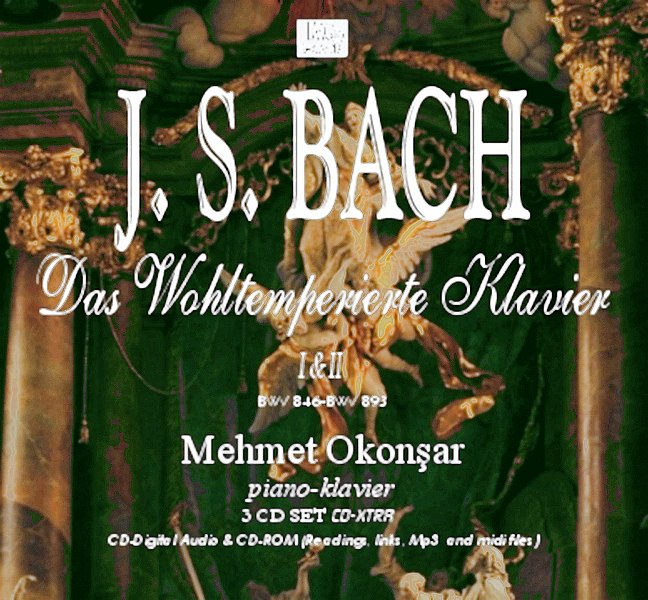
Johann Sebastian Bach
Das Wohltemperierte Clavier - The Well-Tempered Keyboard BWV 846–893
(complete 2 volumes in 3 CD set)

|
“The Well Tempered Clavier, or Preludes and Fugues in all tones and semitones, in major as well as minor, for the benefit and use of musical youth desirous of knowledge as well as those who are already advanced in this study. For their especial diversion composed and prepared by Johann Sebastian Bach currently ducal Chapelmaster in Anhalt-Cöthen and director of chamber music, in the year 1722” This text, appeared as a preface to the First Edition of the First Book of the Well Tempered Keyboard has been a source of vehement discussions among scholars for many centuries. I believe the above paragraph to be the most correct and concise description of what is the Well Tempered Keyboard and I would like to comment shortly on it here. ‘Well Tempered’ refers to the tuning system developed by Andreas Werckmeister in 1691. In short, that tuning system, by shifting down the pure fifth intervals thus modifying the pure harmonic ratios between sounds permits one to compose and perform on all keys. A facility previously unavailable, only a range from all naturals (C major) up to keys with some three or four accidentals was practically usable. ‘Clavier’ means nothing else keyboard. Those pieces are then intended for keyboard. That keyboard may be a Clavichord, Harpsichord, a pipe organ and from today’s point of view: piano and electronic keyboards. In other words, Well Tempered Keyboard is to be played (if it is to be played at all) on any keyboard. Which keyboard with what sort of sounds is left to the discretion of the performer. Thereafter come few interesting wordings. One of them is: for the benefit and use of musical youth desirous of knowledge (“Lehrbegierigen Musicalischen Jugend”). Here Bach, points out, as in many of his published works, the pedagogical aspect of the Well Tempered Keyboard. Here, as it is common at that time, the musical education comprises both performance and composition. Following that, he mentions those who are already advanced in this study (“in diesem studio schon habil seyenden”). Very interestingly, this reminds me few works by Joseph Schillinger (Kaleidophone) and Nicolas Slonimsky (Thesaurus of Scales and Melodic Patterns) because those not widely known but immensely worthy composers of our time have published similarly targeted books. Forcing somewhat on the analogy, it also makes me think of some Artificial Intelligence oriented musical computer software such as Band in A Box™ or Jammer™ and their specific ‘style libraries’. The benefit and use of those who are already advanced in this study can well be thought as addressing to working composers, using the styles and musical ideas presented in the Well Tempered Keyboard in composing their own music. That practice was quite common in Bach’s days and he himself have made many transcriptions of contemporary works by other composers, I believe those transcriptions were serving a similar purpose. I am sure for a composer as practically minded and over-busy as J. S. Bach, making such a ‘styles catalog-library’ have been very profitable in ‘cataloguing’ his own ideas and compiling many other ones ready for practical uses, then it was a natural next step to publish it since if it serves his own purposes it may also serve others as well. We shall keep in mind that publishing a musical work was a non-negligible financial investment and the composer, personally had to endorses it. The fact that the Well Tempered Keyboard (except for few ones) does not show performance oriented ornaments (unlike the Goldberg Variations for example) reveals that his intention was not to publish a work designated to be performed by others. Again, the original preface states that clearly. The aim was study and compositional use of it as ‘ideas-generating’ templates and ‘musical thesaurus’. When we consider the Well Tempered Keyboard as a set of musical styles templates and not as a series of pieces to listen in succession, the "unmusical" ordering of the pieces in reference to their tonalities and to the moods of them makes sense. Listening to pieces raising chromatically by half steps in succession is a pain to (even) our modern ears and Bach has never composed such a tonal nonsense in any his larger pieces (Suites, Partitas etc.) as well as the inconsistency in succession of strong-soft, brilliant-intimate pieces repudiates the idea behind of listening the Well Tempered Keyboard as a whole in succession. I recommend the listener to use from time to time the ‘Random Play’ features of the CD Player, even if it separates few very nicely connecting preludes and fugues, it can make the whole listening experience quite interesting (!). When one looks at the relationship between the preludes and their related fugues, the CONTRAST relations seem more frequent. Those contrasts happen as SLOW-FAST or vice-versa (ex. VOL I Eb Maj. No.7 CD-I Track 13 and 14; VOL I B Min. No.24 CD-II Track 10 and 11) and STRONG-SOFT or vice-versa (ex. VOL II C# Min. No.4 CD-II Track 18 and 19; VOL II G# Min. No.18 CD-III Track 16 and 17). Besides that, preludes that are ‘preparing’ the fugue and smoothly leading to it (as a Prelude is always supposed to do) are mostly to be found in the first Volume. Some examples of them: VOL I C Maj. No.1 CD-I Track 1 and 2; VOL I C Min. No.2 CD-I Track 3 and 4; VOL I C# Min. No.4 CD-I Track 7 and 8. Those preludes that are nicely leading to their respective fugues show also close stylistic unity as a pair. Sometimes one finds a much more developed and extended prelude than its related fugue (ex. VOL I Eb Maj. No.7 CD-I Track 13 and 14; VOL II C# Min. No.4 CD-II Track 18 and 19). That ‘excessive’ stylistic variety seems to me a proof of the Well Tempered Keyboard being a set of musical style templates. Not even the Goldberg Variations shows that much unrelated variety. 19th. Century tradition residues make for irrelevant concepts about the tonalities and character relationship in Bach’s works. The character and tonality relationship of a piece was not clearly defined and widely used until Beethoven. For Bach this is simply a superficial relationship. Bach has compiled, modified and transposed many pieces to fit into the Well Tempered Keyboard. The transpositions we know about have been made from C to C# or F to G or F to A flat. Looking for a deeply ‘organic’ relationship between the prelude and its fugue as in the movements of a Beethoven’s Sonata, or searching for a mathematical ratio among the tempi of a given Prelude and its Fugue or even, as an author did once, seeking references to the Bible in the occurrences of themes all through the Well Tempered Keyboard can be an amusing pastime and I am sure J. S. Bach would be the one to laugh most on the results. But if one tries to figure out what is the Well Tempered Keyboard and for what reason it has been composed why not to read once more what the composer says about: “The Well Tempered Clavier, or Preludes and Fugues in all tones and semitones, in major as well as minor, for the benefit and use of musical youth desirous of knowledge as well as those who are already advanced in this study. For their especial diversion composed and prepared by Johann Sebastian Bach currently ducal Chapelmaster in Anhalt-Cöthen and director of chamber music, in the year 1722”
|
|||||||||
| |
|||||||||
| |
|||||||||
|
|
|||||||||
|



